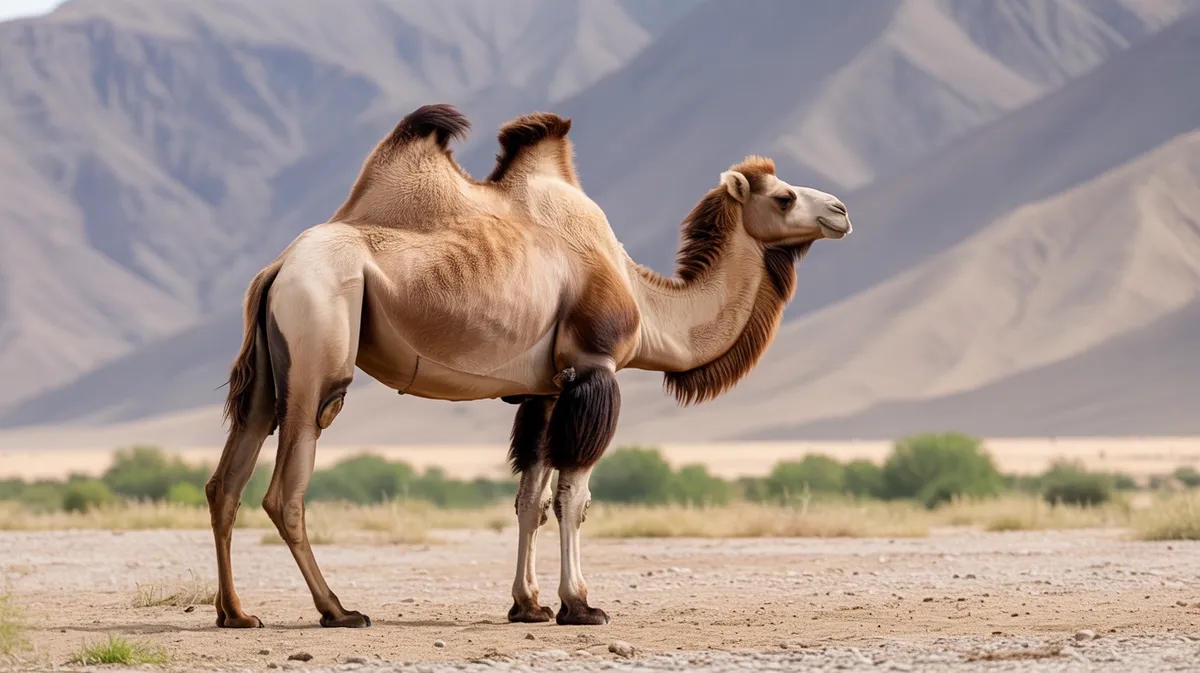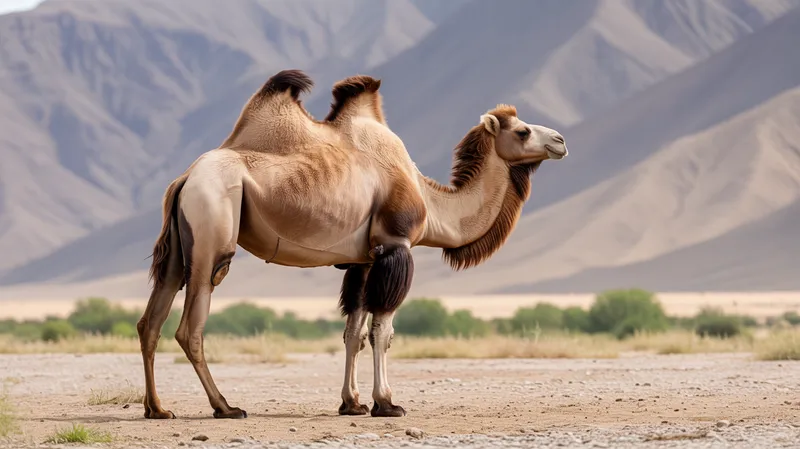
Bactrian Camel
Camelus bactrianus

Meet the Bactrian Camel
The Bactrian camel is a large, even-toed ungulate native to the steppes of Central Asia. Distinguished by its two humps, it is well-adapted to harsh desert and semi-desert environments, enduring extreme temperatures from scorching heat to freezing cold. Its thick fur, bushy eyebrows, and double-layered eyelashes protect it from sandstorms and cold winds. Bactrian camels are highly valued as pack animals and for their milk, meat, and wool. Despite their resilience, wild populations are critically endangered, while domesticated Bactrian camels are more numerous.
Classification
Mammal
Habitat
Desert and semi-desert steppes
Diet
Herbivore
Lifespan
40–50 years
Conservation
Critically Endangered (wild), Domesticated population is not threatened
Weight
300–1,000 kg (660–2,200 lbs)
📖Fascinating Facts
Two Humps
Unlike the single-humped dromedary, Bactrian camels have two humps that store fat, not water.
Extreme Survivors
They thrive in environments with temperature ranges from -40°C to 40°C (-40°F to 104°F).
Nutritious Milk
Bactrian camel milk is rich in vitamins and nutrients and is a vital resource for nomadic peoples.
📋Detailed Description
The Bactrian camel (Camelus bactrianus) is a large, robust mammal distinguished by its two prominent humps, which store fat reserves vital for survival in harsh environments. Adult males typically stand 180–230 cm at the shoulder and may weigh between 600 and 1,000 kg, while females are slightly smaller. Their dense, shaggy coats—ranging from sandy beige to dark brown—provide insulation against both extreme cold (down to -40°C) and heat (up to 40°C). The coat is shed in spring, revealing a shorter summer fur. Bactrian camels have broad, tough footpads adapted for traversing rocky and sandy terrain, and their split upper lips aid in grasping sparse, thorny vegetation. Their nostrils can close to block sand, and their long eyelashes and bushy eyebrows protect their eyes from dust and glare. Socially, they are gregarious, forming herds of up to 30 individuals, typically led by a dominant male. Bactrian camels are diurnal, spending much of the day foraging and resting. Their digestive system is highly efficient, allowing them to extract nutrients from tough desert plants and tolerate high salt intake. They are capable of drinking up to 57 liters of water in one session and can survive for weeks without water by metabolizing fat from their humps. Domesticated for over 4,000 years, they remain essential for transport, milk, meat, wool, and hides in Central Asian cultures.
💡 Did you know?
Wild Bactrian camels can drink salty or brackish water, making them one of the few mammals able to survive in such harsh conditions.
🔬Research & Sources
Wikipedia Summary
The Bactrian camel, also known as the Mongolian camel, domestic Bactrian camel or two-humped camel, is a camel native to the steppes of Central Asia. It has two humps on its back, in contrast to the single-humped dromedary. Its population of 2 million exists mainly in the domesticated form. Their name comes from the ancient historical region of Bactria.
Last Modified: 5/31/2025
🎭Behavior & Social Structure
Bactrian camels are primarily grazers and browsers, feeding on a wide variety of vegetation including dry grasses, shrubs, and halophytes (salt-tolerant plants). They exhibit a slow, deliberate gait and can travel 30–40 km per day when necessary. Herds are usually composed of related females and their offspring, with males either solitary or forming bachelor groups outside the breeding season. Social hierarchies are established through displays and occasional physical contests, especially among males during rut. Camels are known for their calm demeanor but can become aggressive during mating season. They communicate through vocalizations (grunts, moans, bellows), body postures, and even spitting as a defensive behavior. Daily routines involve early morning and late afternoon foraging, with rest periods during the hottest part of the day. In the wild, they are highly nomadic, moving in response to resource availability.
👶Reproduction & Life Cycle
Bactrian camels are seasonal breeders, with mating typically occurring from December to March. Males display pronounced rutting behavior, including increased aggression, foaming at the mouth, and neck rubbing. After a gestation period of approximately 13 months (390–410 days), females give birth to a single calf, though twins are rare. Calves are precocial, standing and nursing within hours of birth. Weaning occurs at 1–2 years, but young may remain with the mother for longer. Sexual maturity is reached at 3–5 years. Parental care is provided exclusively by the female, who is highly protective of her offspring. Breeding intervals are usually two years, allowing the mother to recover and ensure calf survival.
🛡️Adaptations & Survival
Bactrian camels possess numerous adaptations for survival in extreme environments. Their humps store fat, which can be metabolized for energy and water during scarcity. The thick, woolly coat insulates against cold and is shed in warmer months. Their kidneys and intestines are highly efficient at conserving water, producing concentrated urine and dry feces. Blood cells are oval-shaped, allowing for continued circulation during dehydration. Their split lips and tough mouths enable them to consume thorny, salty, or dry plants avoided by other herbivores. Behavioral adaptations include the ability to tolerate body temperature fluctuations, reducing the need for sweating and minimizing water loss. Their wide, padded feet prevent sinking into sand and protect against rocky surfaces.
📚Research Sources
🎨Cultural Significance
Bactrian camels have played a central role in the cultures of Central Asia for millennia. They were vital to the Silk Road, transporting goods across vast deserts and facilitating trade between East and West. Their milk, known for its high vitamin and mineral content, is a staple in nomadic diets, while their wool is used for textiles and their hides for leather goods. Camels are featured in folklore, art, and traditional ceremonies, symbolizing endurance, wealth, and adaptability. In Mongolia and China, camel festivals celebrate their importance, featuring races and beauty contests. They are also depicted in ancient petroglyphs and are associated with spiritual beliefs in some cultures.
🔬Recent Research & Discoveries
Recent genetic studies have clarified the distinction between domestic Bactrian camels (Camelus bactrianus) and the wild Bactrian camel (Camelus ferus), confirming they are separate species with significant genetic divergence. Ongoing research focuses on camel physiology, particularly their remarkable water conservation mechanisms and tolerance to extreme dehydration, which may have biomedical applications. Studies on camel milk have identified unique antimicrobial and hypoallergenic properties. Conservation genetics projects aim to monitor hybridization rates and maintain the genetic integrity of wild populations. Ecological research is also examining the impact of climate change on camel habitats and migration patterns.
🎥Wildlife Videos

World of Camels | A Short Documentary | Wildlife | Animals Documentary
camels #desert #animals Welcome to our channel! Join us as we explore the fascinating world of camels, the incredible animals ...
Cosmos Therapy

The double-humped, wild Bactrian camel is one of the least-studied animals in the world
pet #animal Which place do you find the double humped camel in Ladakh? Nubra valley The animal is also known as Bactrian ...
Animal Square

"The World of Camels: Documentary A Teaching Story""Camel Footsteps: The Fragrant Essence
Shaheen Wildlife

Wild Camels Nature's Desert Nomads
camel #desert #wildlife #nature #documentairy #explore #discovery Join us as we venture into the rugged desert and witness the ...
Wild nature

Beyond the Dunes: Exploring the Camel's World | Animal Documentary
Beyond the Dunes: Exploring the Camel's World | Animal Documentary A Desert 🏜️ is a landscape characterized by its arid ...
WILD ECOSYSTEM - Animal Documentary

The Wild Camel
Documentary video about the wild camel and the WCPF organization (Wild Camel Protection Foundation). More info: ...
Alejandro Llop
🌍Habitat Information
The Bactrian Camel typically inhabits Desert and semi-desert steppes environments. Bactrian Camels have adapted to their environments with specialized features and behaviors.
Primary Habitat:
Desert and semi-desert steppes
More detailed habitat information will be available soon.
🛡️Conservation Status
The Bactrian Camel is currently classified as Critically Endangered (wild), Domesticated population is not threatened. Conservation efforts are crucial for preserving this species for future generations.
Common Threats:
- 🏠Habitat loss and fragmentation
- 🌡️Climate change impacts
- 🎯Hunting and poaching
- 🏭Human-wildlife conflict
⚠️Threats & Conservation Challenges
While domesticated Bactrian camels are numerous and not threatened, the wild population (Camelus ferus) is critically endangered, with fewer than 1,000 individuals remaining in remote regions of the Gobi and Taklamakan deserts. Major threats include habitat loss due to mining and human encroachment, competition with livestock for water and forage, poaching, and hybridization with domestic camels. Climate change exacerbates water scarcity and reduces suitable habitat. Disease transmission from domestic herds also poses a risk. Conservation efforts focus on habitat protection, anti-poaching measures, and genetic studies to preserve the wild gene pool.
🔬Scientific Classification
Scientific Name
Camelus bactrianus
Classification Hierarchy
🔍 About Taxonomic Classification
Taxonomic classification is a hierarchical system used by scientists to classify and organize living organisms based on shared characteristics and evolutionary relationships.
The system moves from broad categories (Kingdom) to increasingly specific ones, with each animal's scientific name typically consisting of its Genus and species.
📝Community Notes
Share your observations and insights about the Bactrian Camel with our community of wildlife enthusiasts.
Join Our Community
Sign in to share your observations and connect with fellow wildlife enthusiasts.
Sign In to ContributeNo community notes yet
Be the first to share your observations about the Bactrian Camel!
Explore Bactrian Camel
Select a tab above to learn more about this amazing animal.
📸Photo Gallery
No photos available for this animal yet.
🌟Discover More Wildlife
Continue your journey of discovery with more fascinating animals from our database
